Galfer Wave Rotor Review

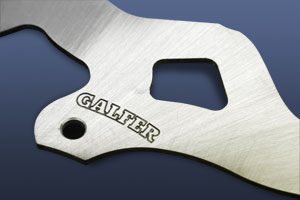 Galfer
Wave® rotors are made of a proprietary 420 high carbon stainless
steel for increased memory retention during heat cycles
Galfer
Wave® rotors are made of a proprietary 420 high carbon stainless
steel for increased memory retention during heat cycles
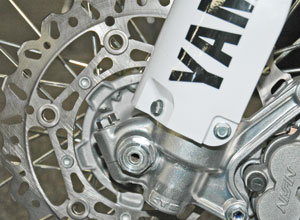 HOW
OVERSIZE BRAKE ROTORS WORK
HOW
OVERSIZE BRAKE ROTORS WORK
When you think about performance and how to win races, it's speed
and horsepower that quickly comes to mind. Although the power of
your motorcycle is an important factor, controlling that power is
equally as important in the recipe to get you to the podium. All of
that forward momentum needs to be slowed and stopped at the
appropriate times on your way to the finish line and that control
comes from your brakes.
Many riders replace their stock brake rotors with oversized
aftermarket rotors from companies like Galfer and Braking USA. What
exactly is an oversized brake rotor going to do for you that the
stock rotor won't, to help you get into that win column?
First, it's best to understand how the whole braking process works
in order to understand how an oversized rotor improves it.
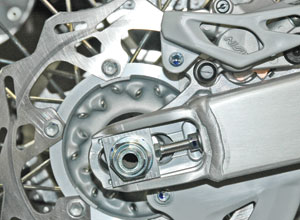 Disc brake basics
Disc brake basics
Force transmitted from your brake lever to the calipers
hydraulically causes them to squeeze the brake pads against the
rotor. Friction between the pads and the disc slows the disc down.
Pretty simple so far, however a moving motorcycle has a certain
amount of kinetic energy built up, and the brakes must remove this
energy from the bike in order to stop it. How do the brakes do
this? Each time you stop your bike, your brakes convert the kinetic
energy to heat generated by the friction between the pads and the
disc. The quicker you can transfer kinetic energy to heat and
remove the heat, the quicker you can stop. The rotor dissipates the
generated heat over the surface that is not in contact with the
pads. The larger the surface, the greater the cooling area. Heat
that transfers to the rotor must be dissipated or the rotor will
warp. Warping is most often caused by excessive heat buildup. It's
all about removing energy from the motorcycle by converting it to
heat witout overheating the parts that are performing this
function.
The main causes of overheating are: undersized/overmachined brake
rotors and/or excessive braking in racing situations or when
descending hills/mountains.
Larger Diameter Rotors
The advantage of a larger diameter disc is that it provides more
stopping power, and better cooling by transferring kinetic energy
to heat and removing that heat quicker than a stock rotor is
capable of. The oversized rotor does this because the portion of
the rotor that is dissipating heat is larger than that on a stock
rotor, allowing the oversized rotor to manage more heat faster. The
larger surface on the oversized disc dissipates the heat quicker
because of this larger "cooling" surface that is not in contact
with the brake pads. The area that is in contact with the pads is
where all the friction and heat are being generated. The advantage
of oversized rotors is this ability to whisk away more of the heat
that is being generated.
A common disadvantage, especially with offroad motorcycles, is that
the larger size rotor has a greater chance of coming in contact
with something potentially damaging, like a rock, fallen tree or
even the motorcycle of another racer.
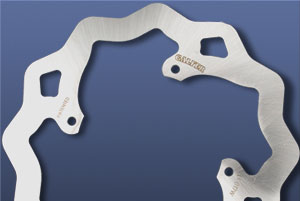 Wave Rotors
Wave Rotors
Oversized wave rotors are designed with a wave along the edge
instead of the perfectly round edge of a standard rotor. This
allows the rotor to cool even more efficiently. On a normal round
rotor, the leading edge of the brake pad is in contact with the
entire height of the rotor as the pressure is applied. Because the
contact covers the entire height of the rotor heat takes much less
time to occur and you end up with heat related problems like brake
fade, thermal lock up and inconsistent braking performance. What
the wave pattern does is take the leading edge of contact between
the blade and pad and constantly move it up and down, thus
minimizing heat build up and its inherent problems.
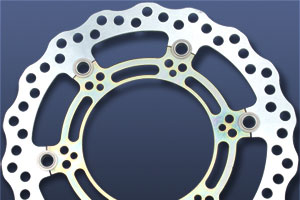 Floating Rotors
Floating Rotors
Rotor warping occurs when there is excessive heat and the disc's
friction area is at a substantially higher temperature than the
inner portion causing the thermal expansion of the friction area to
a greater degree than the inner portion of the rotor. Floating
rotors were designed to eliminate this problem by creating a
separate inner portion and allowing the friction area to float.
"Floating" rotors decouple the friction area from the inner portion
and allow thermal expansion to occur at different rates that would
otherwise warp a solid rotor.
Benefits of better braking
The benefits of all this kinetic energy and heat management is
immediately evident once you've made the conversion from stock
rotors to oversized wave and floating rotors. For motocrossers it
is the ability to brake later in corners that oversized rotors
allow that translates into lower lap times. For offroaders in
sitiuations of excessive braking such as long down hills you will
eliminate the risk of of warping your rotor, eliminate brake fade
while improving the overall feel of your brakes. With an oversized
rotor you will experience more consistant braking under excessive
braking conditions without the common heat related problems
normally associated with heavy braking improving your confidence
and riding.
